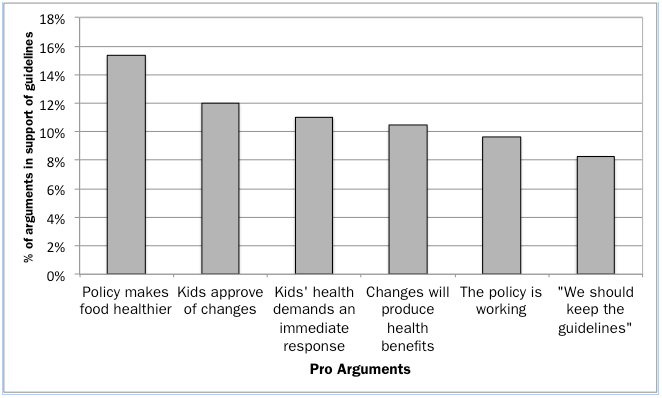
Examining the Public Debate on School Food Nutrition Guidelines: Findings and Lessons Learned from an Analysis of News Coverage and Legislative Debate
This study, conducted by PHI’s Berkeley Media Studies Group (BMSG) in collaboration with the Public Health Advocacy Institute, provides a look at how discussions of school food nutrition policies unfolded in the selected states in the wake of a landmark national policy—the Healthy, Hunger-Free Kids Act (HHFKA).
- Lori Dorfman, DrPH, MPH
- Laura Nixon, Karra Gardin, Lillian Seklir, Mark Gottlieb
-
Focus Areas
Chronic Disease Prevention, Women, Youth & Children -
Issues
Nutrition & Food Security, School-based Efforts -
Programs
Berkeley Media Studies Group

Understanding how school nutrition has been portrayed in the news is key for advocates working to build support around the country for policies that promote and maintain healthy school environments.
This study, conducted by PHI’s Berkeley Media Studies Group (BMSG) in collaboration with the Public Health Advocacy Institute, provides a look at how discussions of school food nutrition policies unfolded in the selected states in the wake of a landmark national policy—the Healthy, Hunger-Free Kids Act (HHFKA).
 In 2010, President Barack Obama signed the HHFKA, the first piece of legislation in more than 30 years to include substantial reforms to the United States Department of Agriculture’s (USDA) school nutrition guidelines. In the five years since it passed, the new standards for the National School Lunch Program have been implemented in schools across the country. Some of the new guidelines include increasing offerings of whole grain-rich foods, increasing daily servings of fruits and vegetables, and offering only fat-free or low-fat milk. “Smart Snacks in School,” another program implemented under HHFKA in 2014-15, requires that all foods sold at school during the school day outside the meal program—foods sold in vending machines, at fundraisers or events, which are known as “competitive foods”—also meet the same nutrition standards.
In 2010, President Barack Obama signed the HHFKA, the first piece of legislation in more than 30 years to include substantial reforms to the United States Department of Agriculture’s (USDA) school nutrition guidelines. In the five years since it passed, the new standards for the National School Lunch Program have been implemented in schools across the country. Some of the new guidelines include increasing offerings of whole grain-rich foods, increasing daily servings of fruits and vegetables, and offering only fat-free or low-fat milk. “Smart Snacks in School,” another program implemented under HHFKA in 2014-15, requires that all foods sold at school during the school day outside the meal program—foods sold in vending machines, at fundraisers or events, which are known as “competitive foods”—also meet the same nutrition standards.
These programs are intended to provide nutritionally balanced meals and snacks to U.S. schoolchildren in an effort to address child hunger and promote good nutrition. Since these programs target low-income children across the country, the new nutritional standards could improve the health of the children most at risk for diabetes and other chronic health problems related to diet.
While Congress and the USDA are responsible for developing nutritional guidelines for school meals and competitive foods, implementation falls under state jurisdiction, and execution varies across the country. While many states have embraced the guidelines, others have undermined support for robust school nutrition policies, insisting they will impede individual liberties, fail to adequately feed children or result in massive food waste.
It is important to understand how debate about this precedent-setting policy has unfolded in either the news media or legislative spheres at the state and local level. Previous analysis of HHFKA in print and television news at the federal level showed a national conversation with many opportunities for advocates to improve their messaging. An understanding of how school nutrition has been framed in news coverage and policy debates at the state and local level since the passage of the HHFKA could provide valuable insights for advocates who are eager to see strong implementation in their schools. News coverage influences both how the public and policymakers perceive an issue and what they think should be done about it. Understanding the coverage is key for advocates working to build support around the country for policies that promote and maintain healthy school environments.
To that end, BMSG examined state- and local-level debates about school food nutritional guidelines since implementation of the HHFKA in a divergent group of states. We explored questions like: What topics were discussed, who speaks about school nutrition guidelines in state- and local-level news and policy debates, and how do they talk about the issue? This study provides a look at how discussions of school food nutrition policies unfolded in the selected states in the wake of a landmark national policy.
Originally published by Berkeley Media Studies Group
Work With Us
You change the world. We do the rest. Explore fiscal sponsorship at PHI.
Support Us
Together, we can accelerate our response to public health’s most critical issues.
Find Employment
Begin your career at the Public Health Institute.


